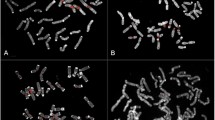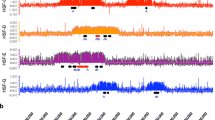Abstract
The spatial relationship between the families of repetitive DNAs present at the centromeres of human chromosomes and the position of the kinetochore was examined by combining immunocytochemistry with the PRINS oligonucleotide primer extension technique. Heterochromatic domains were decondensed with 5′-azacytidine to facilitate this study. Using this approach our results clearly show that the alphoid DNA sequences are closely associated with the kinetochore of human chromosomes. Simple-sequence satellite DNAs occupy separate, non-overlapping domains within the centromere. These two major families are separated by a third, relatively low-copy repetitive DNA family, SAU-3A. Pulse-field gel electrophoresis was employed to analyse the centromeric domain of human chromosome no. 9 in more detail and the results although preliminary support the conclusions drawn from the immunocytochemistry/PRINS approach.
Similar content being viewed by others
References
Agresti A, Rainabli G, Lobbiani A, Magnani I, DiLernia R, Meneveri R, Siccardi AG, Ginelli E (1987) Chromosomal location by in situ hybridization of the human Sau3A family of DNA repeats. Hum Genet 75: 326–332
Agresti A, Meneveri R, Siccardi AG, Marozzi A Corneo G, Gaudi S, Ginelli E (1989) Linkage in human heterochromatin between highly divergent Sau3A repeats and a new family of repeated DNA sequences (HaeIII family). J Mol Biol 205: 625–631
Aleixandre C, Miller DA, Mitchell AR, Warburton DA, Gersen SL, Disteche C, Miller OJ (1987) p82H identifies sequences at every human centromere. Hum Genet 77: 46–50
Beauchamp RS, Mitchell AR, Buckland RA, Bostock CJ (1979) Specific arrangements of human satellite III DNA sequences in human chromosomes. Chromosoma 71: 153–166
Bickmore WA, Maule JC, vanHeyningen V, Porteous DJ (1989) Long-range structure of H-ras 1-selected transgenomes. Somatic Cell Mol Genet 15: 229–235
Denhardt DT (1966) A membrane filter technique for the detection of complementary DNA. Biochem Biophys Res Commun 23: 641–646
Doneda L, Ginelli E, Agresti A, Larizza L (1989) In situ hybridization analysis of Interstitial C-heterochromatin in marker chromosomes of two human melanomas. Cancer Res 49: 433–438
Donlon TA, Magenis RE (1983) Methyl green is a substitute for distamycin A in the formation of distamcyin A/DAPI C-bands. Hum Genet 65: 144–146
Earnshaw WC, Rothfield N (1985) Identification of a family of a family of human centromere proteins using autoimmune sera from patients with scleroderma. Chromosoma 91: 313–321
Gosden JR, Mitchell AR, Buckland RA, Clayton RP, Evans HJ (1975) The location of four human satellite DNAs on human chromosomes. Exp Cell Res 92: 148–158
Gosden JR, Lawrie SS, Cooke HJ (1981) A cloned repeated DNA sequences in human chromosome heteromorphisms. Cytogenet Cell Genet 29: 32–39
Haaf T, Schmid M (1990) Kinetochore formation in experimentally undercondensed chromosomes. Hum Genet 84: 535–538
Haaf T, Feichtinger W, Guttenbach M, Sanchez L, Muller CR, Schmid M (1989) Berenil-induced undercondensation in human heterochromatin. Cytogenet Cell Genet 50: 27–33
Jeppesen P, Mitchell A, Turner B, Perry P (1992) Antibodies to defined histone epitopes revealed variations in chromatin conformation and underacetylation of centric heterochromatin in human metaphase chromosomes. Chromosoma 101: 322–332
Jorgensen AL, Bostock CJ, Bak AL (1986) Chromosome-specific subfamilies within human alphoid repetitive DNA. J Mol Biol 187: 185–196
Joseph A, Mitchell AR, Miller OJ (1989) The organization of the mouse satellite DNA at centromeres. Exp Cell Res 183: 494–500
Koch JE, Kolvraa S, Petersen KB, Gregersen N, Bolund L (1989) Oligonucleotide-priming methods for the chromosome-specific labelling of alpha satellite DNA in situ. Chromosoma 98: 259–265
Masumoto H, Masukata H, Muro Y, Nozaki N, Okazaki T (1989) A human centromere antigen (CENP-B) interacts with a short specific sequence in alphoid DNA, a human centromeric satellite. J Cell Biol 109: 1963–1973
Mitchell AR, Gosden JR, Miller DA (1985) A cloned sequence, p82H, of the alphoid repeated DNA family found at the centromeres of all human chromosome. Chromosoma 92: 369–377
Mitchell AR, Ambros P, McBeath S, Chandley AC (1986) Molecular hybridization to meiotic chromosomes in man reveals sequence arrangement on the No 9 chromosome and provides clues to the nature of “parameres”. Cytogenet Cell Genet 41: 89–95
Mohandas T, Sparkes RS, Sparkes MC, Shulkin JD, Toomey KE, Funderburk SJ (1979) Regional localization of human gene loci on chromosome 9: Studies of somatic cell cell hybrids containing human translocation. Am J Hum Genet 31: 586–600
Moyzis RK, Albright KL, Bartholdi MF, Cram LS, Deaven LL, Hildebrand CE, Joste NE, Longmire JL, Meyne J, Schwarzacher-Robinson T (1987) Human chromosome-specific repetitive DNA sequences: Novel markers for genetic analysis. Chromosoma 95: 375–386
Pietras DF, Bennet KL, Siracusa LD, Woodworth-Gutai M, Chapman VM, Gross KW, Kane-Hass C, Hastie ND (1983) Construction of a small Mus musculus repetitive DNA library: identification of a new satellite sequence in Mus musculus. Nucleic Acids Res 11: 6965–6983
Pluta AF, Cooke CA, Earnshaw WC (1990) Structure of the human centromere at metaphase. Trends Biochem Sci 15: 181–185
Prosser J, Frommer M, Paul C, Vincent PC (1986) Sequence relationships of three human satellite DNAs. J Mol Biol 187: 145–155
Reeves R, Nissen MS (1990) The A.T.-DNA-binding domain of mammalian high mobility group I chromosomal proteins. J Biol Chem 265: 8573–8582
Rigby PWJ, Dieckmann M, Berg RC (1977) Lebelling deoxyribonucleic acid to a high specific activity in vitro by nick translation with DNA polymerase I. J Mol Biol 113: 237–251
Schmid M, Grunert D, Haaf T, Engel W (1983) A direct demonstration of somatically paired heterochromatin of human chromosomes. Cytogenet Cell Genet 36: 554–561
Schwarzacher-Robinson T, Cram LS, Meyne J, Moyzis RK (1988) Characterization of human heterochromatin by in situ hybridization with satellite DNA clones. Cytogenet Cell Genet 47: 192–196
Singer MF (1982) Highly repetitive sequences in mammalian genomes. Int Rev Cytol 76: 67–112
Southern EM (1975) Detection of specific sequences among DNA fragments separated by gel electrophoresis. J Mol Biol 98: 503–517
Tyler-Smith C, Brown WRA (1987) Structure of the major block of alphoid satellite DNA on the human Y chromosome. J Mol Biol 195: 457–470
Vissel B, Choo KH (1989) Mouse major (γ) satellite DNA is highly conserved and organized into extremely long tandem arrays: implications for recombination between nonhomologous chromosomes. Genomics 5: 407–414
Vogt P (1990) Potential genetic functions of tandem repeated DNA sequence blocks in the human genome are based on a highly conserved ‘chromatin folding code’. Hum Genet 84: 301–336
Wahl GM, Stern M, Stark GR (1979) Efficient transfer of large DNA fragments from agarose gels to diazobenzyloxymethyl-paper and rapid hybridization by using dextran sulphate. Proc Natl Acad Sci USA 76: 3683–3687
Warburton PE, Willard HF (1990) Genomic analysis of sequence variation in tandemly repeated DNA. J Mol Biol 216: 3–16
Waye JS, Willard HF (1989) Human β satellite: Genomic organization and sequence definition of a class of highly repetitive tandem DNA. Proc Natl Acad Sci USA 86: 6250–6254
Waye JS, England SB, Willard HF (1987) Genomic organization of alpha satellite DNA on human chromosome 7: Evidence for two distinct alphoid domains on a single chromosome. Mol Cell Biol 7: 349–356
Wevrick R, Willard HF (1989) Long-range organization of tandem arrays of α satellite DNA at the centromeres of human chromosomes: High frequency array-length polymorphism and meiotic stability. Proc Natl Acad Sci USA 86: 9394–9398
Willard HF, Waye JS (1987) Hierarchical order in chromosome-specific human alpha satellite DNA. Trends Genet 3: 192–198
Wong AKC, Rattner JB (1988) Sequence organization and cytological localization of the minor satellite of mouse. Nucleic Acids Res 16: 11645–11661
Wong AKC, Biddle FG, Rattner JB (1990) The chromosomal distribution of the major and minor satellite is not conserved in the genus Mus. Chromosoma 99: 190–195
Author information
Authors and Affiliations
Additional information
by W.C. Earnshaw
Rights and permissions
About this article
Cite this article
Mitchell, A., Jeppesen, P., Hanratty, D. et al. The organisation of repetitive DNA sequences on human chromosomes with respect to the kinetochore analysed using a combination of oligonucleotide primers and CREST anticentromere serum. Chromosoma 101, 333–341 (1992). https://doi.org/10.1007/BF00346012
Received:
Revised:
Accepted:
Issue Date:
DOI: https://doi.org/10.1007/BF00346012




